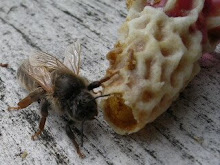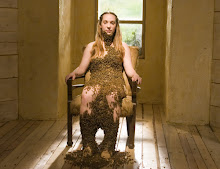Recap of the 2011
Washington State Beekeepers Convention
For Methow Valley Beekeepers
By Craig Lints
There
were dozens of presentations and an enormous amount of material that was
presented at the convention. Many
of the talks were by scientists and were way over my head. What follows is not a complete recap by
any stretch. But rather, an effort
by me to make sense of what was presented as it applies to a practical,
small-time beekeeper.
Background:
The state of Beekeeping in the USA
The
Apiary Inspectors of America (AIA) and the USDA conduct an online survey to
estimate honeybee colony losses annually. Local beekeepers are encouraged to
participate. Go to http://beinformed.org
Historically,
losses of 10% to 15% were considered normal. In the 1990s, the tracheal mite pushed these numbers to over
20%. Since the varroa mite has
been a problem, these losses have pushed 30%. For small beekeepers (< 50 hives) in the Pacific
Northwest, WSU and OSU estimate that over 40% of colonies were lost last
winter.
These
numbers are just for winter losses, based on reporting in the first two weeks
of April. There are summer
problems such as Colony Collapse.
So the full extent of the losses is probably well in excess of a third
of all colonies in the USA each year.
Everyone
in the industry is concerned. The
situation is becoming increasingly fragile. At some point, the capacity of the queen and package
industry to keep up with demand could be overwhelmed.
This
increased demand is reflected in pricing for packages. In the 1980s, a package equated to
about 20lbs of honey at wholesale pricing. Even with the very high prices of honey today, a package now
costs over 50 lbs of honey.
Scientists
and beekeepers all over the country are trying to figure out what is going on
and how to restore hive health. In
particular, new genetic and molecular tools are being applied to the problem.
There
is mounting suspicion that the problems the industry face are an accumulation
of a lot of issues:
1. Varroa is certainly the most serious problem. There is a new product available that
shows a great deal of promise called Hop Guard. I will discuss this more below.
2. Tracheal mites and Nosema
3. Poor queens.
Many of the presentations addressed this.
4. Nutritional problems brought about by monoculture agribusiness
5. Sub-lethal effects of pesticides and fungicides
that accumulate in pollen and wax.
6. Although there was very little presented at the
convention on Colony Collapse, it was clear that there is no “smoking
gun.” It is worth noting that CCD
is a “symptom” not a disease.
WSU
has a diagnostics lab that is available to all Washington beekeepers. This
lab is there to help you! Go to http://apis.wsu.edu
Data
presented at the convention, based on last year’s samples from Washington and
Oregon, showed that 85% of samples had varroa mites, 50% had nosema and 40% had
tracheal mites. These are
astonishing levels of disease.
Organic, Natural, or Sustainable Beekeeping
There have been
efforts going back to 2002 to establish a standard for “organic” honey. The problem of course is that bees work
a huge area. Last year, the National Organic Standards Board finally came up
with a formal recommendation. Go
to: http://www.ams.usda.gov/AMSv1.0/getfile?dDocName=STELPRDC5087792
The standard has not been adopted
and it is my understanding that no honey can be labeled as organic at this
time.
The proposal will be
very difficult to comply with. For
example, the beekeeper must identify all possible sources of contamination
within a “forage zone” extending 1.8 miles from the apiary and a “surveillance
zone” that extends 2.2 miles beyond that.
This is an area of 10 square miles and 46 square miles
respectively. Imagine a beekeeper
with several yards of hives miles apart.
Another term that is
used by hobby beekeepers is “natural” beekeeping. The implication is that, if left alone, bees will do
just fine. This is naïve at
best. Most hives that are left
alone will die the first winter from varroa and almost all will die by the end
of the second summer.
A similar argument is
that feral hives represent the solution.
There is a great deal of interest in the genetics of surviving feral
hives. However, these colonies do
not necessarily represent a complete solution. As an example, one presenter pointed to feral colonies in
the southern states, where the Africanized bee is making inroads
genetically. These traits survive
because the African bee swarms and absconds often, which is a cleansing
mechanism, the queens hatch earlier, and the bees are very mean.
So that leaves us
with “sustainable” beekeeping.
Beekeeping is moving to an IPM (Integrated Pest Management) system that
will involve more labor; labor to
monitor hive health and labor to deploy a range of treatments. Practically, this means that, except in
winter, the beekeeper will need to inspect hives every 10 –14 days.
Taking varroa as an example, an IPM system would:
a)
Monitor mite levels by
one or more method:
i)
Screened bottom / sticky
board
ii)
Sugar shake, ether shake
or alcohol shake
iii) Lab tests (See WSU site above)
b)
Mechanical controls
i)
Sugar dusting with
screened bottom board
c)
Biological Controls
i)
Drone brood removal
ii)
Small cell brood
foundation
iii) Interrupting brood cycle
iv) Annual re-queening
d)
Chemical controls
i)
Formic Acid
ii)
Hop Guard
Ideally, an IPM
system would use two different types of control that work by different methods.
Varroa Control
Because the varroa
mite is such a critical problem today, I will summarize what I learned from
several presenters.
It is important to
understand the life cycle of the mite.
During brood rearing, half of the mites present are on the brood and
half attached to adult bees (phenetic).
However, over winter all the mites are phenetic because there is no
brood. Mites increase
exponentially in the spring along with the expanding brood nest.
This presents an
opportunity for control. If mites
are suppressed to very low levels coming out of winter, the hive will
thrive. So a low initial level of
10 mites, becomes 20, becomes 40, becomes 80. Contrast that with a high initial level of 500, becomes
1000, becomes 2000, etc. (My numbers are just examples, not based on real
data.)
If a hive starts the
year with high mite loads, you will be fighting a losing battle all
summer. A low level in the spring
will keep the mite under control until fall. Then a single treatment in the
fall could be enough.
There was a great
deal of buzz about Hop Guard at the convention. Hop Guard is available through Mann Lake Ltd.
Go to: http://www.mannlakeltd.com/
Hop Guard is approved
in Washington State. It is a
natural byproduct of beer making.
It is food grade. Tests
show no residue in honey. It only
affects the phenetic mites. As a
reslult, several treatments are required over a complete brood cycle of 21
days.
Since Hop Guard only
affects the phenetic bees, drone brood removal would be an example of a second
IPM method that complements it.
Other Issues affecting Honey Bee Health
There were a variety
of presentations related to honey bee nutrition. For example, just like the human gut, scientists know that
the bee gut is a thriving environment for bacteria and viruses. Using modern genetic tools, scientist
are trying to determine which of these are normal and which are detrimental.
Another concern is
the loss of natural habitat. With
monoculture, bees increasingly eat a sequential mono-diet. (As a human, imagine eating nothing but
almonds for a month, then apples for the next month, etc). One scientist presented data showing
that a bees fed exclusively almond pollen had lower brood viability than bees
fed multiple pollens.
Many of the presenters
commented that “good nutrition is the foundation of hive health.” The importance of nutrition can’t be
overemphasized.
There is also concern
that many pesticides, although tested for lethal effects to honey bees, may
have sub-lethal effects. One presentation
showed that a fungicide used extensively in the almonds dramatically affected
the viability of queen cells.
In that presentation,
it was notable that the scientist took almond pollen from an “organic” orchard
and added the fungicide for the experiment. However, later, when the lab tests came back, there was a
completely different pesticide in both the “treated” and the “untreated”
pollen.
They could not
explain where the pesticide came from.
This illustrates the saying that bees are “flying dust mops” and will
pick up contaminants that the beekeeper is completely unaware of.
Queens and Queen Breeding
There is anecdotal
evidence that commercially raised queens are declining in quality. Queen failure and supersedure seems to
be increasing.
However, one
presenter tested 144 queens from 12 different producers and compared the
results to data going back 40 years and concluded the queens of today are just
as good as they have ever been.
There is some concern
that the problem may be the result of in-breeding. There are 28 sub-species of honey bees in the world. Although eight of these were imported
in the 1800s, only two remain (Italian and Carniolan) with some scattered
genetic evidence of a third (Caucasian).
Washington has a
major queen researcher in Susan Colbey, who is splitting her time between WSU
and UC Davis. She and several graduate students went to Slovakia, Italy and
Georgia last year to import sperm from old world sources.
I especially remember
one of her photos in Slovakia. It
showed the “smoker” they used. It
was essentially a large cigarette with a wiff of smoke coming off it. Apparently the bees are very, very
gentle.
She noted that one
should not conclude that “genetic diversity” means raising a mutt cross bee
(Italian/Carniolan/Feral). Instead she is looking for genetic diversity within
a single line of bees.
She is a strong
advocate of locally produced queens.
However, because of the complications involved, she feels this is best
left in the hands of local breeders. She noted that any breeding program is a
long term commitment. It needs
simple and practical methods of evaluating the queens such as queen size, brood
viability, temperament, over-wintering survival, disease/pest resistance and hygienic behavior.
The Good News
I don’t want to leave
the impression that the sky is falling.
For example, the Methow is largely insulated from problems that affect
beekeepers in other parts of the country such as pesticides and monoculture.
And some beekeepers
are having success. I particularly
remember Paul Hosika, who keeps about 75 hives in southeast Washington, with
weather very similar to ours. He
raises his own queens and consistently produces over 100 lbs of honey per hive
each year. This year he produced
10,000 lbs.





